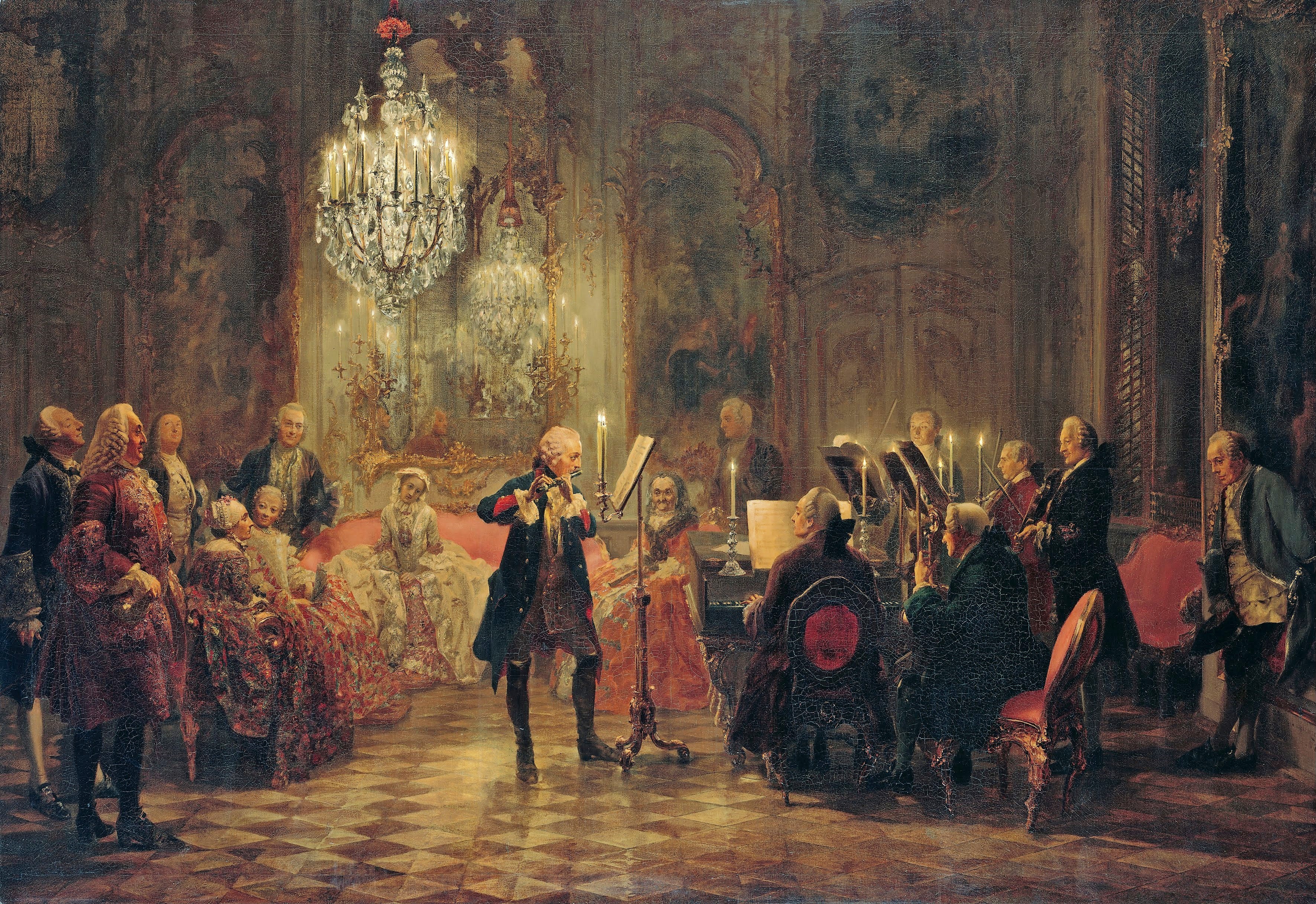 The ‘Flute Concert with Frederick the Great in Sanssouci’, an oil on canvas,
hanging in the halls of the Alte Nationalgalerie in Berlin is one the more
famous works of the German master Adolph von Menzel. The work depicts the
intimate circle of Frederick the Great of Prussia, gathered in one of the halls
of the palace Sanssouci, listening to a flute concert performed by the Prussian
King. Sanssouci was built by Frederick as a getaway from the pressures and
crowds at court, and this work captures that spirit of Sanssouci
perfectly,embracing the small audience (of ten persons) and its six performers tightly within the aura of light
generated by a couple of candles and a single chandelier above.
The ‘Flute Concert with Frederick the Great in Sanssouci’, an oil on canvas,
hanging in the halls of the Alte Nationalgalerie in Berlin is one the more
famous works of the German master Adolph von Menzel. The work depicts the
intimate circle of Frederick the Great of Prussia, gathered in one of the halls
of the palace Sanssouci, listening to a flute concert performed by the Prussian
King. Sanssouci was built by Frederick as a getaway from the pressures and
crowds at court, and this work captures that spirit of Sanssouci
perfectly,embracing the small audience (of ten persons) and its six performers tightly within the aura of light
generated by a couple of candles and a single chandelier above. Though the audience was somewhat
larger than that the audience depicted in Flute
Concert, there was something of this sense of intimacy at a concert of
three young sopranos trained by Dona Juliana De Sa. Perhaps numbering not more
than a hundred odd, the audience was gathered in the handsomely proportioned
hall, which operates sometimes as music room, sometimes as art gallery, in CasteloVermelho, the home of the artiste couple Rudolf Kammermeier and Yolanda De
Souza.
Though the audience was somewhat
larger than that the audience depicted in Flute
Concert, there was something of this sense of intimacy at a concert of
three young sopranos trained by Dona Juliana De Sa. Perhaps numbering not more
than a hundred odd, the audience was gathered in the handsomely proportioned
hall, which operates sometimes as music room, sometimes as art gallery, in CasteloVermelho, the home of the artiste couple Rudolf Kammermeier and Yolanda De
Souza. As with the Flute Concert what marked this special concert was the intimacy of
the gathering, of artistes within breathing distance of their audience,
reaching out to each other in the course of performance, and the blessed
absence of amplified sound. What this concert, and other concerts that have
been held at Castelo Vermelho, do, is to draw our attention to the
possibilities of chamber music. A fledgling group of Carnatic musicians in
Madras, the ‘Oli Chamber Concerts’ team, has recently taken up the cause of chamber concerts for Carnatic music in that city, arguing that “We do not use any kind
of amplification…. A mike is used only to record the concerts. With a smaller
and serious audience we hope to explore themes that cannot be explored in a
sabha concert”.
As with the Flute Concert what marked this special concert was the intimacy of
the gathering, of artistes within breathing distance of their audience,
reaching out to each other in the course of performance, and the blessed
absence of amplified sound. What this concert, and other concerts that have
been held at Castelo Vermelho, do, is to draw our attention to the
possibilities of chamber music. A fledgling group of Carnatic musicians in
Madras, the ‘Oli Chamber Concerts’ team, has recently taken up the cause of chamber concerts for Carnatic music in that city, arguing that “We do not use any kind
of amplification…. A mike is used only to record the concerts. With a smaller
and serious audience we hope to explore themes that cannot be explored in a
sabha concert”.
If the flow of emotion between
performer and audience is one of the benefits of the chamber concert then there
was one event, held in the Dinanath Mangueshkar Auditorium in the Kala Academy,
that may have benefited tremendously from the ambience of a chamber concert.
The memorial concert to Lea Rangel-Ribeiro held on the 22 of February 2012
seemed to have been done a great disservice by the choice of its location. The concert featured works that were especially dear to the departed Lea Rangel-Ribeiro,
and were played (and conducted) with great emotion by her husband and daughter.
However a good amount of this feeling was lost thanks to the distance between
performers and audience, a loss amplified by the unfortunately small turnout at
the concert. Perhaps a smaller location, not necessarily more exclusive, as the
Oli team suggests, but more intimate may have been a better location for this
event?
(A version of this post was first published in the Gomantak Times 21 March 2012)


No comments:
Post a Comment